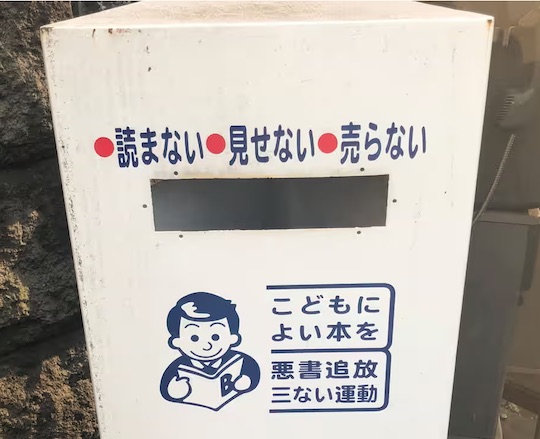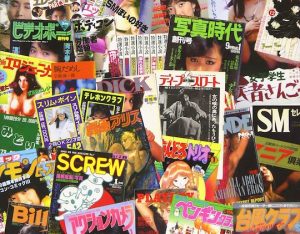The decline of the porn disposal box in Japan
The internet has had an immeasurable impact on sex, from providing access to invaluable advice and information, to enabling people to watch hardcore porn at just the click of a button or swipe and tape of a phone screen.
Some argue that having such easy access to porn all the time is unhealthy, especially at a very young and impressionable age. Some blame the ubiquity of porn for the rise of certain violent sexual preferences, like choking.
In Japan, porn has long been ubiquitous since the emergence of the adult video industry in the 1980s, though porn magazines and books were already big markets before that, and softcore “pink” films also popular.
The rise of online porn has meant the decline of those little “booth” establishments where you could go and watch AV by yourself (serving the needs of guys who lived with family in small Japanese homes with thin walls).
But in other ways, the internet has happily coexisted with porn. We remember our first visits to internet cafes in Japan, which had private booths to watch porn DVDs. The cafe was filled with the sounds of porn and of guys whacking off, and with the smell of semen.
It hasn’t totally killed the market for porn on physical formats quite yet, with releases from the major production companies coming out generally in both streaming and physical formats.
Likewise, gravure magazines still continue to publish print editions alongside the paid digital content they offer, though online media has made it easier to produce and release digital photo books for idols (at the same, cementing the status and prestige of a print photo book — if you get to release one of those, you know you’ve really made it).

But one consequence of online porn has been the phasing out of white disposal boxes.
As reports the Guardian, these boxes are meant to allow people to dispose of books and DVDs in a discreet way. Putting them out with the regular garbage means potentially exposing underage adolescents to the content — not to mention, potentially embarrassing you to your neighbors.
These tactful drop-off boxes — know for being white and covered in messages about protecting children’s wellbeing — are on the decline because, local governments have found, there is less need for them due to the rise of online porn content.
They are often located near train stations and first appeared in the 1960s. “The campaign to install them was led by mothers who didn’t want their children exposed to anything harmful, including pornographic books and magazines,” explains a sociologist who is an expert on shiruposuto, as they are called in Japanese.
The boxes are emptied every few months, though some municipalities do not bother for years, because they rarely get full these days.
“At night, when the streets are less crowded, men of all ages come to get rid of their stuff,” a tax driver says.
Last year, the Guardian notes, Nagasaki closed several of its white boxes after the number of collected items per year dropped from up to 6,000 to 2,000.
But with the baby boomers starting to die off, there could still be a need for places to dispose of old piles of magazines, books, and videos that you would rather others don’t see. Don’t forget about that stash of porn at the back of your wardrobe!
Porn vending machines have also mostly died off, though this could be a consequence of both changing consumption habits (buying fewer magazines, porn or otherwise, or preferring to order such content online) as well as social mores regarding what is acceptable to have out in the open. If you spot one in a more rural part of Japan, it feels like you’ve found the holy grail.















1 Comment
管理人様
(English below)
はじめまして、ストリップチャット広告事業部の村上と申します。
ストリップチャットはヨーロッパ発のアダルトライブチャットプラットフォームとして、
2016年より世界中で多くのユーザーにご利用いただいております。
安全性、使いやすさともに高い評価をいただき、
現在の月間アクセス数は6億を超えております。
またアジア市場、特に日本においても利用者が急増しており、
現在の日本からの月間アクセス数は1.3億に達しています。
また弊社はストリップチャット以外にも
xhamster等のアダルトプラットフォームを運営しており、
アダルト業界では約20年程の実績がございます。
2025年度は昨年に引き続き、
アジア最大のアダルトエキスポ「台北国際成人展」への出展が決定し、
マーケティングやその他プロモーションを含め、
ますます日本を含めたアジア市場へと注力をして参ります。
この機会に是非、貴サイトに当社のアフィリエイト広告掲載をご検討いただきたく、
ご連絡を差し上げました。
《ストリップチャット アフィリエイトプログラム(stripcash)の概要》
1) 広告の掲載方法の例
– テキストリンク、ウィジェット、静止画バナーや動画広告などを掲載(修正素材もございます)
– ストリップチャットのシステムを御社のブランド名でご利用いただけるホワイトラベル形式
2) 報酬に関して
– アフィリエイト広告を通じて会員登録されたユーザーの売上(初回購入・継続購入問わず)の20%を永続的にシェア
※ ユーザーが購入を継続される限り収益が入る仕組みとなっていますので、仮に貴サイトへのアクセスが減少したり、
万が一閉鎖することになりましても、ユーザーが購入を継続される限り報酬は発生いたします。
※ 他社様のライブ配信報酬と比較しましても、20%の継続報酬はメリットが大きいです。
3) 日本人の専属スタッフによるサポート
– 各アフィリエイト様毎に、日本人のアカウントマネージャーが担当となります。
– ストリップチャット直接運営の広告部署となりますので、広告の素材変更や位置変更などにも、細やかに対応させていただきます。
– ご希望に応じて、データ分析によるフィードバック等も適宜させていただきます。
アフィリエイトプログラムの詳しい説明資料:bit.ly/about_affiliate_program
ご興味をお持ちいただけましたら、下記のリンクよりアフィリエイトプログラムへご登録いただけます。
stripcash.com/sign-up/takuji
* 登録画面で連絡手段はSkype / Telegram / Whatsappのどれが良いですか?
といった画面が出てきますが、どれも使用していない場合は、
Skypeの横の欄に “メール” とご記入ください。
ご登録前にご質問等ございましたら、メールへとお気軽にご連絡下さいませ。
お忙しいところ恐れ入りますが、何卒ご検討のほどよろしくお願いいたします。
村上
Dear Admin,
I’m Takuji from Stripcash, a direct advertiser of Stripchat, a leading WebCams platform. I came across your website, tokyokinky, and think there’s a great opportunity for us to collaborate and drive mutual growth.
Here’s how we can partner:
Revenue Share (20%): Earn a 20% commission on every sale and rebill generated through your website.
White Label Option: We’ll create a custom Whitelabel under your brand, with the same 20% commission on sales.
It’s easy to get started—sign up on the Stripchat advertising platform through this link: stripcash.com/sign-up/takuji
I’d love to hear your thoughts or answer any questions about this opportunity. Let me know if you’re interested, and we can discuss the next steps.
Looking forward to collaborating with you!
Best regards,
Takuji